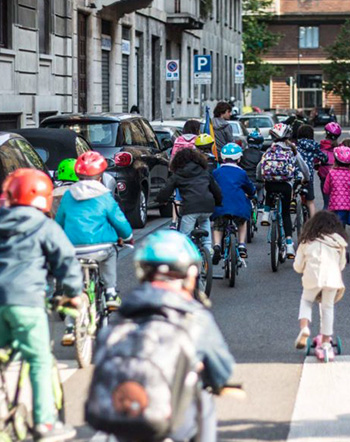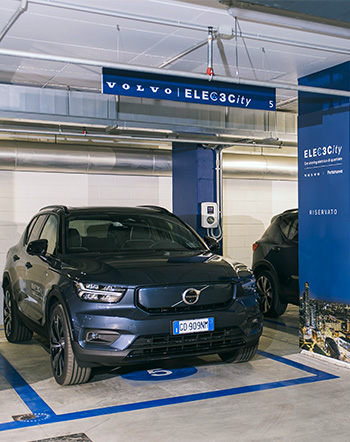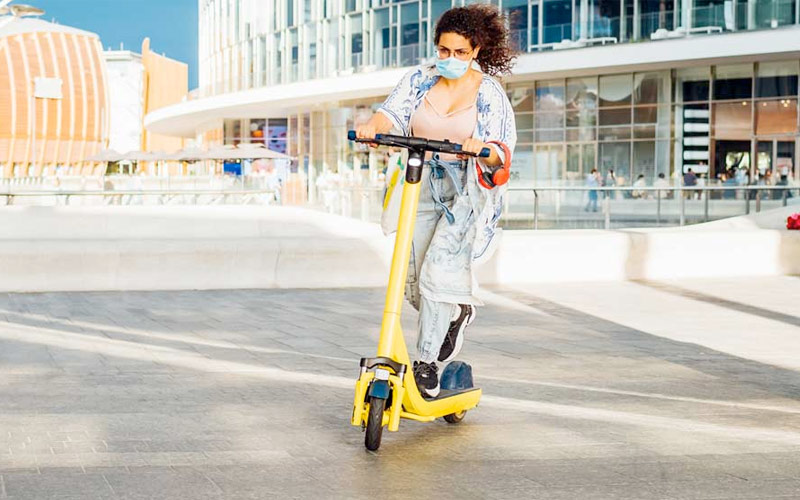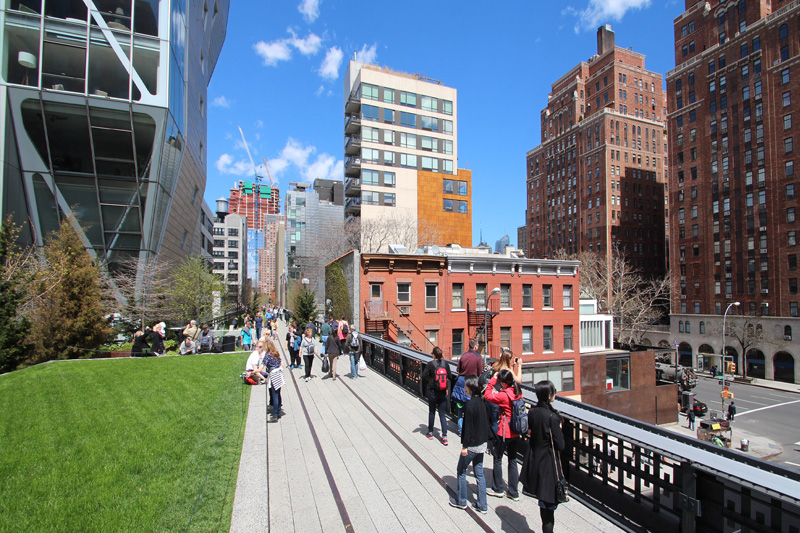A city is defined as “smart” when it implements solutions which make it more efficient, welcoming and sustainable. Mobility plays a crucial role in a “smart” city transformation. Urban regeneration projects must consider citizens’ travel and viability needs to create an increasingly advanced and environmentally friendly transport system.

Kids gathered by Massa Marmocchi go to school by bike
Photo by Matteo Saderis
But what is meant by smart mobility? We asked three different companies in the transport sector: Automotive sector leader, Volvo Car Italia, Milanese Transport Company ATM that provides Milan and its hinterland with integrated and sustainable mobility services, and bicycle school mobility association Massa Marmocchi Milano. This voluntary association founded in 2013 was a spin-off of Critical Mass - a shared and collective mobility two-wheeled event that has enlivened the streets of Milan for 20 years, every Thursday evening.
ATM President Gioia Ghezzi said: “Smart mobility is both an objective and action. It is an objective because we must think consciously about the impact our actions have on the world. It is an action because it is not enough to set long-term objectives, but we need to act practically and immediately to achieve tangible results.”
Public transport is one of the most effective methods for sustainable urban mobility. Volvo Car Italia President and CEO Michele Crisci said: "Smart mobility should integrate and coordinate the coexistence of public and private transport, to guarantee and increase the fluidity of urban and extra-urban traffic sustainably, in the Milan urban environment.”
Massa Marmocchi Milano vice president Luca Boniardi said: “Mobility has a huge impact on the citizens’ quality of life, reducing pollution, and increasing safety and accessibility to services, especially for the most vulnerable such as children and the elderly.”
Read also: Milan, the alternative to megacities
A relevant issue when talking about smart mobility is safety. “ATM adopts a sustainability policy, and a complex and integrated strategic plan where safety plays a central role. Gioia Ghezzi said: “The plan is to achieve greater integration in the urban fabric and provide citizens with spaces and services, energy self-sufficiency and green roofs and walls.” This is additional to the other challenging goals ATM has set itself. These enabled the Milanese transport company to reach a 70 per cent zero-impact service which aims at zero emissions by 2030.
Volvo's CEO believes that safety must be the fundamental requirement in advanced assisted and autonomous driving systems, which will contribute to developing connected and shared mobility. This applies to the Massa Marmocchi - In bici a scuola project, which supports the development of safe and shared home-school routes by bicycle.
Read also: The city of tomorrow? Safe and borderless
Crisci said. “Our mobility will soon be electric-only to safeguard life and the environment where we live and our children will grow up.” Road safety in Italy and Milan is poor. Boniardi said: “The percentages of children travelling independently by bicycle on home-school routes are incredibly low compared to other European cities.”
These words highlight the importance of combining smart mobility and safety. This means rethinking urban spaces and infrastructures, which must be adapted to emerging needs.

Construction works for Milan’s M4 metro line
The new M4 line is expected to lead to a two per cent reduction in Milan's current annual CO2 emissions and will significantly affect road congestion. With this project, ATM implemented bike-sharing services, electric buses and new depots, changing the look of some Milan areas. Gioia Ghezzi added: “New developments will integrate services using smart mobility platforms, such as MaaS - Mobility as a Service. A single tool will provide people access to a range of easy, convenient and customised solutions based on their needs - public transport, bike, micro-mobility and car sharing, taxis, car rental and parking are just some of the services that will coexist in a single digital ecosystem.”
The spread of two-wheeled mobility and electric cars contributes to meeting the stringent environmental sustainability goals. However, these solutions face infrastructure issues daily. Boniardi said: “Milan is a small and predominantly flat city and could become a bike-friendly city with more lanes and adequate infrastructure. Despite the City Council launching recent projects reversing the trend, we are paying the price of the 1950s and 1960s, when the city was designed to favour travel by car and private vehicles.”

Fast charge station, part of the first district electric
car-sharing scheme “ELEC3City” in the Portanuova district
In addition, there is a need to meet these new mobility requirements, i.e., cycle paths and other recharging systems for e-cars. Crisci said: "we are behind on new full-electric cars which are only four per cent of registrations. There are several psychological and physical barriers, such as the spread of fast-charging systems throughout the area, especially the motorway network.” Boniardi added: “The next two or three years will be decisive in understanding whether Italy will succeed in catching up with the other European countries or be the tail end of the market and industry.
"A reduction in cars on the road and a perception of road safety would increase the number of cyclists in the city. Milan has more than 500 cars for every 1,000 inhabitants, compared to 300 in Berlin and 250 in Paris. For example, the 1,500 cyclists who cross the Ghisolfa bridge every day would increase if there was adequate infrastructure.”
Read also: A new urban planning era
“Citizens are waiting to see widespread fast charging facilities on all routes, not only urban, interurban and motorway, before converting to electric mobility. New electric models allow distances comparable to traditional engines and so do the purchase costs,” Crisci said. “Purchase subsidies for individuals and companies and a dedicated and favourable taxation system should be implemented. This is what other European countries are doing or are working towards”
Volvo is quickly expanding its partners' network with ultra-fast “Powerstop” recharging facilities, which provide more than 150KW of power to reassure customers that they can recharge inside and outside the city centre. “Simultaneously, the company is investing in affordable electric car purchase, leasing or rental programmes and the first district electric car-sharing scheme, “ELEC3City”, in the Porta Nuova district.”
Read also: Porta Nuova, the first neighborhood designed for the community
Massa Marmocchi is an association that highlights infrastructural issues of a city with great potential like Milan. It created “Marmocchia Toolkit - Il manuale delle giovani Marmocchie”, which won the “Ricominciamo bene da una Milano Sostenibile” call - an initiative promoted by PuntoSud with the support of the City of Milan and co-funded by the European Union. It supports groups of parents and schools in developing other Masse Marmocchie in the future by creating new home-school routes by bicycle. Boniardi said: “The plan is there; what is missing is the next step that makes infrastructure development standardised and allows us to see tangible changes five years from now.”
Companies must act intelligently, and providing quality transport services will generate additional demand, establishing a virtuous circle. It is necessary to make the most of every enabling factor, such as technology and digital development, to do this. ATM president said: “Impulsive technological development makes it possible to think of scenarios that were unimaginable a few years ago, such as autonomous driving and the established habit of getting on driverless metro networks in Milan. The field of experimentation is rapidly expanding to surface vehicles. Soon citizens and tourists will be able to book their rides via an app, possibly on self-driving shuttles.”
Everyone agrees that a city engaged in transforming its mobility must begin by rethinking its infrastructure, an integral part of any urban regeneration process and a key to meeting its citizens’ needs and expectations.




